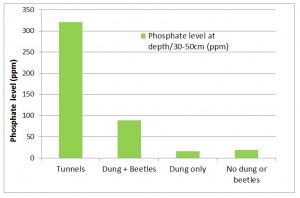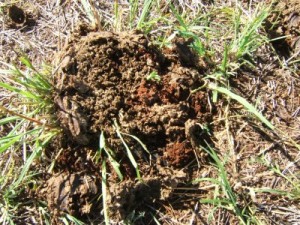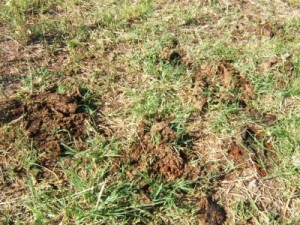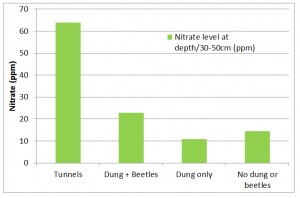Dung Beetles! – These little guys were something that I knew were a great advantage to have on your farm but had really underestimated just how fantastic they can be! I have rarely seen the production advantages of dung beetles measured, and it may really surprise you – it certainly did me.
If you could get a 50% increase in your pasture production, sustained over at least a 9 year period you’d be pretty happy right? Well this is the change capacity that dung beetles possess. And at no cost! So, wouldn’t the smart thing be to make choices that encourage them onto your farm, or to introduce them to your farm if they are not already present?
Dung beetles are a ‘no off farm input’, true regenerator of the soil – and that’s what we’re interested in! Their tunneling aids in rainfall infiltration, breaking up compaction, moving nutrients into the soil and leaving pathways in the soil through which root systems can easily penetrate – and importantly, they help contribute to our bottom line.
Not to mention that they can be pretty fun and interesting to watch! Derek and I were most excited the first time we came across the ball rolling beetles here at home.
So, the question is, how do they achieve regenerative outcomes and how can we encourage them onto our farms?
First let’s take a look at these workers
Most of the species that benefit us on our farms in Australia are introduced species. Species native to Australia do exist, but they are not such major contributors. The introduced species were chosen for their adaptability to cattle dung and for open grassland. Dung beetles are present the world over, with many of the species introduced to Australia coming from Africa and southern Europe.
There are four main types of dung beetles:
- Ball rollers – which shape balls of dung at the dung pat, with one or more eggs inside and roll the ball away to be buried. The balls are buried by excavating the soil from underneath the ball and undermining it.
- Tunnellers – Tunnellers will either dig tunnels, fill them with dung and place eggs in sections throughout the tunnel, or they will dig a chamber at the base of the tunnel, fill it with dung and divide this dung into brood balls. These balls then have an egg layed in each.
- Pad dwellers – these dung beetles breed in the actual dung pad itself.
- Kleptocoprids – These dung beetles take the easy ride and breed in the dung that has been buried by either the ball rollers or the tunnellers.
This is a ball rolling dung beetle at our farm.
The life cycle varies in length and manner between species, but can basically be described in this way.
Eggs are laid by the adult, in most cases, into dung that has been buried underground. The eggs hatch into white grub larvae, which go through several more stages before emerging as an adult beetle. The dung beetles move up the tunnel as it develops through its several stages, feeding on the dung as it goes and excreting it behind them. At full maturation they will emerge from their tunnel and fly or walk to a fresh dung pat. The critical thing for increasing numbers of beetles on your farm is that there are enough beetles present that when a beetle flies to a new dung pat, there is a mate there with which it can mate.
The cycle from adult to adult can take from 6 weeks to several months, depending on the species in your area. This will obviously influence how quickly numbers can build. This is also influenced by the number of eggs that can be laid by a female – which varies from a single egg, up to 100.
If you have some present on your farm it may be helpful to identify what species you have, to see if there are others not present that may be helpful to introduce. We have used a Landcare published ‘Dung Beetle Dictionary’ that we got from our local Catchment Management Authority (CMA) to identify the species on our farm. The information contained in it is also available here online. For those of you in other regions and countries, I’m sure there will be information available about species in your region.
What do they eat?
Fortunately for us, dung is what these guys eat and survive on. When their food source of dung disappears, so will they. Adult dung beetles feed on dung by sucking the juices from it whilst moist. They gain nutrition from digesting the microorganisms that are present in the dung from the gut of the animal, including bacteria, yeasts, protozoa and fungi.
The larvae however, eat all that constitutes the dung, where it has been buried for them by the adult when the eggs are laid. These larvae further digest the plant material present in the dung. Interestingly, the dung beetle larvae have a gut much like a cow’s rumen, full of microbes. Here we see another layer of biodiversity that can be present on our farm, but not necessarily apparent to the unknowing onlooker.
Within a particular species, beetle numbers, size and activity are all affected by the quality of the feed the stock are grazing on. Fresher, more nutritious pastures encourage more numbers, bigger beetles and greater activity than low quality hayed off pastures.
The nature of Australia’s native dung beetles is that they are adapted to dry fibrous pellets of our native marsupial animals. Hence the introduction of dung beetle species that feed and breed well in cattle dung. These can also do well on horse and wet sheep manure. No introduced species will feed on the pelleted dung that is common to sheep.
In the right conditions, certain species of dung beetles can completely bury a cowpat in 24hours. Certain species have been measured at up to 1000 beetles per cow pat under ideal conditions!
You can see these dung piles that have been dried out and partly buried.
Most dung beetles will have seasonal conditions in which they proliferate most, and this is also reflected in their geographical spread. Some are summer active some are winter active – some overwinter as adults while others have just one lifecycle per year, with adults dying after the breeding season.
Some of the dung beetle species introduced to Australia have not colonised all their climate suitable areas yet. If dung beetle numbers are low in your area and you have no reason that they should be low or not present, why don’t you contact one of the dung beetle supply companies? They can advise on species that suit your area and you may be able to introduce some to your farm.
What are the advantages of Dung Beetles?
There are heaps of great things that dung beetles do including:
- Improving pasture production
- Improving pasture composition
- Moving and cycling nutrients to and in the soil
- Increasing soil aeration and rainfall infiltration
- Decreasing soil bulk density
- Increase worm activity
- Increase soil microbiology
- Decrease pasture fouling from manure
I reckon the really cool stuff for our soils happens with the tunneling. Some species will tunnel in a shallow manner under the dung pats when in the feeding stage of their lives, but it is when the beetles dig deeper for the breeding stage when the tunnelling really gets impressive.
Amount of rainfall and hardness of soil will impact how deep a beetle can tunnel, but they can vary from 10cm deep to up to one metre! Typically one might expect feeding tunnels to be 10-15cm, which occur underneath the pat and breeding tunnels up to 50cm deep. When they tunnel for breeding they will lay their eggs in chambers or in balls of dung that will sit at the bottom of the tunnels. Much or all of the tunnel will then be filled with dung, on which the larvae and beetles will feed after hatching.
Nutrient burial and cycling
We not only have the outcome of manure and nutrient burial into pasture root zones and at depth, but we also have the manure broken down further as it is re-processed through the dung beetle larvae stomach and “excreted into the tunnel as a compost- like material, full of available plant nutrients”.1
Just look at the nutrient content of these soil cores taken at depth (30-50cm) 20 months after the burial of dung by dung beetles at a trial site2 on a clay loam soil in South Australia. The chart represents the levels in the dung tunnels and in the soil at depth from the different treatments. Pretty dramatic increases in soil nutrient levels.
Phosphate levels (ppm) at depth (30-50cm).

Nitrate levels (ppm) at depth (30-50cm).
There are similar trends in other trials. Not all trials have improvements of this magnitude, but we can see the potential, and other trial results are still significant and of great benefit from a soil nutrition aspect.
To add to this, the beetles have brought soil from depth to the surface, as they go about digging their tunnels. This is turning nutrients from deeper in the soil to the surface. You can see the deeper red soil brought to the surface in this dung pat.

Note the red soil that has been brought up from depth in this partially buried dung pat.
Soil structure
The tunnels created by dung beetles then form an easy passage through which root systems can penetrate deeper into the soil, through which rainfall can infiltrate, reducing bulk density of the soil and aerating the sub soil. There is trial work which quantifies increased infiltration and decreased bulk density.
Pasture Production
Let’s face it though, the reason we want to improve our soils is so that we can produce more pasture to grow more and healthier livestock and to ultimately make a healthy profit. So, how can dung beetles help us here?
The longest set of trial data from Australia spans over a 9 year period, with the pasture production in t/ha of dry matter monitored over that time. This comes from the same trial mentioned above, in South Australia on a duplex soil of loam over clay, which was relatively infertile. Both dung and dung beetles were applied just once, in late September of the first year, following which the beetles buried the dung over a matter of a few weeks. This was monitored for the next 9 years.
With no animals present (and hence no dung) over the remaining 9 year period, there was no continued beetle activity, as once the dung was buried by the initial dung beetle application, there was then no longer any food source. So, the benefits which lasted for 9 years are benefits as a result of the one off dung and dung beetle activity.
So, what were the benefits?
The first two years produced a phenomenal response – an extra 93% pasture growth! (5.4t/ha versus 2.8t/ha). In the following 7 years there was a 30% increase in pasture production.
So, over the 9 year life of the trial the combined dung and beetle application produced 50% more pasture production. Really amazing results, and for free!
These pasture growth results were compared to:
- Control (No application of dung or beetles)
- Dung only application.
Note that there was no substantial difference between the control plots and the dung alone application, to which the conclusion can be made that the benefits are coming from the addition of the beetles into the system).
The pastures in this trial were rye, clover and phalaris.
Similar results have been seen in other trials in the early years, but no other trials have lasted so long.
The large responses in years 1 and 2 are most likely due to increased nutrient levels in the root zone of the pastures – buried there by the dung beetles. Subsequent years may have been a response to improved soil structure from the tunneling of the beetles.3
Earthworms
Several studies have shown that earthworm numbers are increased in the presence of dung beetle occupied dung pads. These effects are more exaggerated at depth in the soil.
Soil Microbial Activity
Authors of “Dung Down Under”, Bernard Doube and Tim Marshall point out in their book that it seems there has been no work done on the effects that the burial of dung has on soil microbial activity, and they suggest that this is an important area for future research.
Carbon
Sequestering or placing carbon into soils through varying means are increasingly being recognised as acceptable means for reducing atmospheric carbon levels. This is evidenced by the recent acceptance of grazing systems as a methodology for the Australian Carbon Farming Initiative. Dung beetles can contribute to placing carbon in soils as they bury the organic matter from the dung relatively deep into the soil. This is evidenced in total soil organic carbon levels from the South Australian trial. Again, levels are at a depth 30-50cm.
I am regularly impressed with farmers’ and the ag industry’s ability to innovate. It has even been trialled in Western Australia that cattle are fed carbon rich biochar in feed supplements. The carbon that was consumed by cattle and passed through in their dung (about 330g/hd/day), was then buried into the soil by dung beetles (during the active beetle time of year). The Biochar is an extremely stable form of carbon and will likely only leave that soil in our lifetimes if it is physically eroded away. It has been proposed that “such permanent changes in soil carbon should readily qualify for carbon credits”.4
Not only are there the atmospheric impacts on placing carbon into the soil, but also the water holding capacity and other plant specific benefits of carbon rich soil.
Pest Control
Each spring when the weather warms up we get a lot of little black bush flies on our farm, which any Australian will know, can be pretty irritating! When this happens, we just hang in there for around a month or so, because we know each year that once the summer active dung beetles fire up it will mean the end to the little black bush flies for the year. It makes for a much nicer working environment!
As explained earlier, the dung beetles consume much of the juice from the dung pat, leaving dried out fibrous material. What this means is that the moist environment in which the flies breed is removed. This is significant, given that 2-3000 flies can result from just one cow dung pat.5
Similarly, the burying of the pat means that the environment necessary for the life cycle certain of gut parasites of livestock, such as roundworm, fluke and tapeworm is reduced or eliminated. Studies show that reductions in the numbers of these parasites is achieved in the presence of dung beetles, which remove the dung pat from which the eggs of these parasites hatch.
How to encourage more Dung Beetles to your farm?
Given all of these fantastic things that dung beetles can contribute to our farm businesses, what can we do to attract more?
Everyone must surely be aware that if you are using chemicals for parasite control then there is certain chemistry that should be avoided, and other chemistry that is considered ‘safe’ for dung beetles. Please be aware of these and make choices that are not toxic to dung beetles. Similarly, any use of insecticides in pastures should be similarly considered.
Alternatively, use drenches during times of little beetle activity and adhere to withholding periods before beetles become active.
The dung beetle presence and level of activity on our farm prior to our planned grazing compared with now is something quite amazing. We haven’t introduced any beetles, but they have proliferated under the planned grazing system. We have a smallish paddock that surrounds our house yard and on grazing it during the summer months when our dung beetle species are active is quite an experience. There is one variety that flies to a new dung pat every evening at dusk. It is a buzz of activity for the very defined period that it flies and then it stops as they all nestle into their new homes for the night. When grazing our cattle around our house yard is when we realise how abundant they are, as we hear a constant ring of ‘pings’ on our netting fence as they fly to their next meal.
Grazing the way that we do also means that dung piles are more evenly spread across the paddock, rather than being tracked and deposited back to water points. This means the nutritive benefits of the dung is spread across the whole paddock.
If you have low dung beetle numbers on your farm and you are already avoiding any chemicals that would be toxic to them, it may be worth exploring if there is a species that is appropriate to introduce. We have no winter active dung beetles here, and the experts tell me there are no species that seem like they would proliferate readily in our winter environment. There is one species we could trial, but it is great that we know what is available.
Beetles can be introduced to a farm. They can be purchased in boxes from several suppliers that I know of. Bernard Doube of Dung Beetle Solutions in South Australia sells starter packs of 1000 winter active beetles for around $700 gst incl which are delivered to you in the post. There are packs of 1000 with 2 or 3 summer active species for the same price. You can speak with Bernaud about whether there are species suitable to your area and climate. I have been chatting with Bernard and he is most happy to help. Both he and a chap named John Feehan in Canberra (ACT, Australia) are both well renowned dung beetle experts who both supply dung beetles. Both these gentleman are easily accessible and are definitely worth a call.
We have identified what we think is 9 different species on our farm and the pictures I have used are all from home. Despite having had masses of them over summer for some years now, I was unaware at the significant impact they can have on soil nutrition and structure. Bernard Doube pointed out to me that there is a building effect, in that once the beetles are present, the soil structure is improved, which makes it easier next time for the beetles to dig deeper, further improving the soil. Studies and trial work on dung beetles continues, as well as work to see if there are other suitable species that may be able to be introduced to Australia. I know we would love one here that would be active in the winter.
I’m wondering if you see many dung beetles in your area?
If numbers are low in your area – why do you think this is?
References
Much of this material has been taken from the following book and from direct contact with the author Bernard Doube. Thanks for this fantastic resource.
1, 3 & 4. Doube, B. & Marshall, T. (2014) Dung Down Under. Dung Beetle Solutions Australia, South Australia.
2. Doube, B. (2008) The Pasture Growth and Environmental Benefits of Dung Beetles to the Southern Australian Cattle Industry – Final Report.Meat and Livestock Australia, North Sydney. http://www.mla.com.au/CustomControls/PaymentGateway/ViewFile.aspx?xDlEowKRvPqxMxDU6P2Qleohjb15OXKCLD+TLV1sPI6k+qZKC9gsAO95TtT3pb7J3EYMKKAfsht7d1Tnt3BqiA== (Viewed 1/8/14)









Having just moved from Caroona to Wongwibinda (near Ebor) I wasn’t sure if I would see many dung beetles but I have just noticed some activity in the last week. Considering that we haven’t had any maximum temperatures above 15 degrees recently I was surprised to find them at this time of the year and with little soil moisture to speak of. I am not sure of the variety but will endeavour to find out. I know that there was a big push to introduce dung beetles to the area years ago so it will be interesting to see if a change in grazing management can see them return. When I changed my grazing management (in particular ceasing broadacre spraying and using ‘safe’ dung beetle parasite control on the cattle) at Caroona I noticed an almost instantaneous return of dung beetles. They are out there. We just need to encourage them to return to our farms.